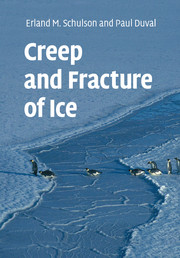Book contents
- Frontmatter
- Contents
- Preface
- Acknowledgements
- 1 Introduction
- 2 Structure of ice
- 3 Microstructure of natural ice features
- 4 Physical properties: elasticity, friction and diffusivity
- 5 Plastic deformation of the ice single crystal
- 6 Ductile behavior of polycrystalline ice: experimental data and physical processes
- 7 Modeling the ductile behavior of isotropic and anisotropic polycrystalline ice
- 8 Rheology of high-pressure and planetary ices
- 9 Fracture toughness of ice
- 10 Brittle failure of ice under tension
- 11 Brittle compressive failure of unconfined ice
- 12 Brittle compressive failure of confined ice
- 13 Ductile-to-brittle transition under compression
- 14 Indentation fracture and ice forces on structures
- 15 Fracture of the ice cover on the Arctic Ocean
- Index
- References
11 - Brittle compressive failure of unconfined ice
Published online by Cambridge University Press: 01 February 2010
- Frontmatter
- Contents
- Preface
- Acknowledgements
- 1 Introduction
- 2 Structure of ice
- 3 Microstructure of natural ice features
- 4 Physical properties: elasticity, friction and diffusivity
- 5 Plastic deformation of the ice single crystal
- 6 Ductile behavior of polycrystalline ice: experimental data and physical processes
- 7 Modeling the ductile behavior of isotropic and anisotropic polycrystalline ice
- 8 Rheology of high-pressure and planetary ices
- 9 Fracture toughness of ice
- 10 Brittle failure of ice under tension
- 11 Brittle compressive failure of unconfined ice
- 12 Brittle compressive failure of confined ice
- 13 Ductile-to-brittle transition under compression
- 14 Indentation fracture and ice forces on structures
- 15 Fracture of the ice cover on the Arctic Ocean
- Index
- References
Summary
Introduction
Ice fails under compressive loads in a variety of situations. During the exploration and extraction of oil and gas from ice-infested waters, for instance, risers must be protected against impact, necessitating a defense system sufficiently strong to resist both local and global failure. The forces can be large. The 110-meter wide Molikpaq exploration platform, deployed in the Canadian Arctic, experienced on 12 April 1986 interactions with a multi-year hummock 8–12 meters in thickness that led to global loads that were estimated to have reached 420 MN (Frederking and Sudom, 2006) or about 68% of the design load (Klohn-Crippen, 1998). Similarly, the 100-meter diameter Hibernia platform, now in production in the North Atlantic Ocean approximately 315 kilometers southeast of St. John's, Newfoundland, was designed and built to withstand global ice loads of about 1300 MN that could arise through interactions with icebergs (Hoff et al., 1994). In these instances and others like them the limiting load was/is set by brittle compressive failure of the ice (Chapter 14).
Compressive loading threatens not only the integrity of off-shore structures, but also the arctic sea ice cover itself. The cover extends over an area of about 12 million km2 and plays a significant role in both local and global climate (e.g., Zhang and Walsh, 2006, and references therein). It is loaded under compression by wind and ocean currents (Thorndike and Colony, 1982). When strong enough, this forcing induces stresses that break the ice, through processes we discuss in Chapter 15.
- Type
- Chapter
- Information
- Creep and Fracture of Ice , pp. 236 - 265Publisher: Cambridge University PressPrint publication year: 2009



